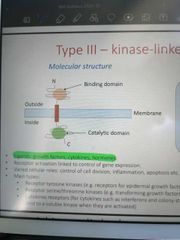![]()
![]()
![]()
Use LEFT and RIGHT arrow keys to navigate between flashcards;
Use UP and DOWN arrow keys to flip the card;
H to show hint;
A reads text to speech;
25 Cards in this Set
- Front
- Back
|
What is a drug? |
A chemical compound that, when applied to a biological system, alters its function in a specific and reproducible manner |
|
|
What is a drug target? |
Any biological binding element for drugs |
|
|
What are the four main types of drug targets? |
Receptors Ion channels Carriers or transporters Enzymes |
|
|
What is affinity? |
The association of a drug with its target. Higher affinity means the drug is more able to bind to its target |
|
|
What is efficacy? |
The ability of a drug to activate the target and produce a response |
|
|
What is a receptor? |
A cellular macromolecule that recognises and responds to endogenous chemicals |
|
|
What are the 4 types of receptor? |
Type 1 - ligand gated ion channels (inotropic) Type 2 - GPCRs (metabotropic) Type 3 - kinase-linked receptors Type 4 - nuclear receptors |
|
|
What timescale do type 1 receptors operate on? |
Milliseconds |
|
|
What timescale do type 2 receptors operate on? |
Seconds |
|
|
What timescale do type 3 receptors operate on? |
Hours |
|
|
What timescale do type 4 receptors operate on? |
Hours/days |
|
|
What gives rise to different subtypes of receptors? |
Different genes Post-transcriptional modification such as mRNA splicing and editing |
|
|
How does mRNA splicing work? |
When removing introns from pre-mRNA, the exons may be reordered to form multiple versions, giving rise to different amino acid structures |
|
|
How does mRNA editing work? |
Substitution of bases resulting in AA sequence change |
|
|
Give an example of a type 1 receptor |
Nicotinic acetylcholine receptor - has 4 transmembrane @-helices and a large N-terminus binding domain. Multiple subunits, ACh must bind to two of these to open the channel |
|
|
What are GPCRs? |
G-protein coupled receptors, they have 7 transmembrane @-helices, a large N terminus binding group and a C terminus G-protein coupling domain. |
|
|
How do GCPRs work? |
Upon binding of a ligand to the GPCR, the protein undergoes a conformational change which activates the G protein inside the cell. This goes on to activate second messengers and produce a response |
|
|
What are the 3 main types of G-protein? |
Gs - stimulatory G protein Gi - inhibitory Gq - binds to phospholipase C |
|
|
Describe the process of G-protein activation |
G-proteins are heterotrimeric and consist of an @, B and gamma subunit. Upon conformational change, the GDP bound to the @ will be exchanged for GTP, dissociating the @ from the B/g dimer. Both of these are free to laterally diffuse and activate other receptors. When the GTP is hydrolysed, the system reverses and deactivates |
|
|
Give some examples of G-protein targets |
Adenylyl cyclase - Gs/Gi Phospholipase C - Gq Ion channels Rho kinase MAP kinase |
|
|
What does adenylyl cyclase do? |
Acts to transform ATP to cAMP, an important second messenger |
|
|
What does phospholipase C do? |
Activate PIP2, leading to IP3 and DAG production, an important part of Ca2+ release |
|
|
Give an example pathway involving adenylyl cyclase and cAMP |
Adrenaline binds to B1 receptor in cardiomyocyte, triggering G-protein to activate adenylyl cyclase. This reacts ATP to form cAMP, which produces protein kinase A and allows Ca2+ influx to cause muscle contraction |
|
|
Give an example pathway involving phospholipase C and IP3 |
Noradrenaline binds to @1 receptor in smooth muscle cell. Activates Gq to trigger PLC, producing IP3 which binds to receptors on sarcoplasmic reticulum. This releases Ca2+ into the cell and causes contraction |
|
|
Describe how type 3 receptors work |

Kinase-linked receptors act to control gene expression. They have a large N-terminus binding site and a large C terminus catalytic site |

